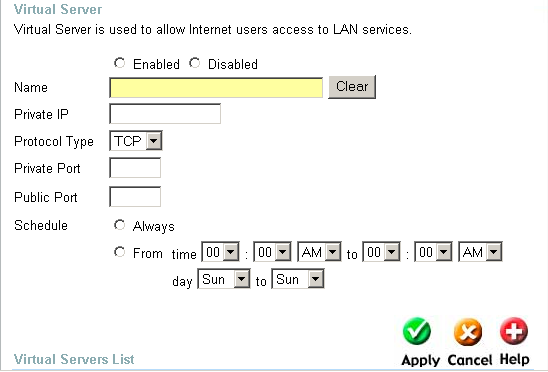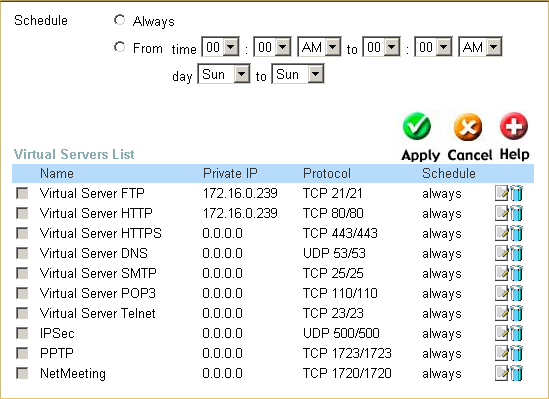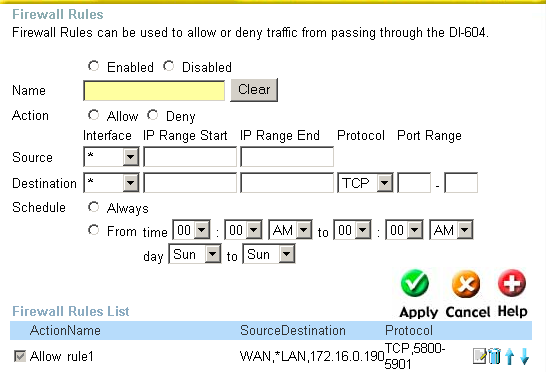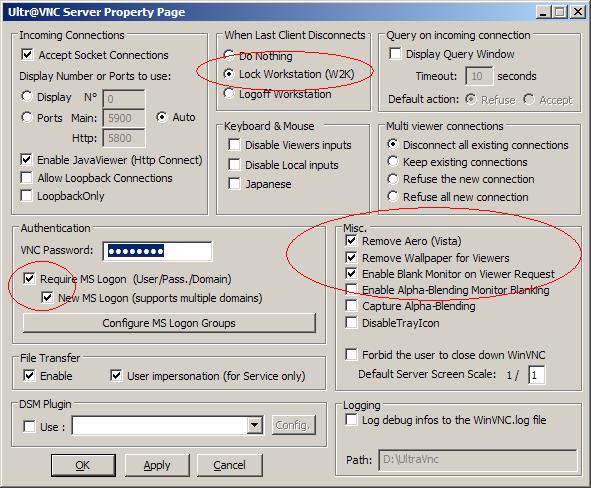Articles > Networking
UltraVNC 1.0.5+ Tutorial
Last Updated: 7/10/11Overview
UltraVNC is just one flavor of VNC (Virtual Network Computing). All flavors of VNC are similar enough that this tutorial should apply to all of them. VNC is software that allows you to control a computer remotely. It is free and easy to use once you get the hang of it. See my tutorial for help setting it up.
UltraVNC is just one flavor of VNC (Virtual Network Computing). All flavors of VNC are similar enough that this tutorial should apply to all of them. VNC is software that allows you to control a computer remotely. It is free and easy to use once you get the hang of it. See my tutorial for help setting it up.
Tutorial
- First download the newest version (1.0.9.6.1) of UltraVNC here:
http://www.uvnc.com/downloads/ultravnc.html
Then install UltraVNC, install the video mirror driver if it asks. You will need to install UltraVNC as a service if you are going to use some of the more advanced features. As a general rule, if you are on a domain you will want to install UltraVNC as a service. If you are just a home user you may not need to install UltraVNC as a service, but you can still do so. There really isn't any downside. Reboot after Installation.
- UltraVNC, or any similar product, works best for people who have a high speed connection (i.e. cable, DSL, LAN, satellite, etc..). You must also have your computer ON to be able to connect to it. You can use UltraVNC with dial-up assuming your computer is online and you have someone at home that knows enough to tell you what your IP address is, because people with dial-up internet get a different IP address every time they connect. Most Residential high speed connections use a dynamic IP address that does change if you turn off your modem or lose your connection. Business level internet normally gets a static ip address that doesn't change. If you have a residential connection your address shouldn't change often, but you can keep track of it using a service like no-ip.com or a program like DynamicIP. Both are free.
- After installing you will need to configure your setup before you can use it. If you have a router read step 4. If you have a firewall read step 5. If you have both read steps 4 and 5.
Note: The actual port that UltraVNC uses is set in the program options. It can use any available ports. Substitute the correct ports anytime that you see 5800 or 5900 during this tutorial. Also note that almost this entire tutorial is talking about setup on the server side. In other words this tutorial shows you how to setup UltraVNC on the computer you will be connecting to (server), not the computer you will be connecting from (client).
- ROUTER: If you have a router it will have to be configured to let it know where to forward incoming requests from the internet to your computer. Log onto your router. If you have never done this then:
Windows 95/98/ME Users: Go to Start Menu > Run > Type "winipcfg" select your network adapter. Then right down the IP address of the "Default Gateway" and the number that just says "IP Address". An IP address is four sets of numbers separated with periods, with one to three numbers in each set, between the numbers 1 and 254, and since you have a router it will probably start with 192.168.xxx.xxx or 10.xxx.xxx.xxx (although it could be any combination of numbers).
Windows 2000 / XP / Vista Users: Go to Start Menu > Run > Type "cmd". Then at the command window type "ipconfig" write down the IP address of the "Default Gateway" and the number that just says "IP Address". It should be the same format as the Windows 95/98/ME IP address.
After you have your gateway IP address open up your internet browser. In the address bar type "http://" then your gateway IP address. If a window pops up asking for a username or your browser goes to a page that has your routers name somewhere then you've done it right. If you got an error then you may have entered the gateway IP address incorrectly. Double check the gateway IP address. If it still doesn't work you may have a telnet based router instead of a web base one. You will need to see my router page. Ok now you need a name and a password to log on. Most routers use a username of "admin".The password is probably blank, "admin", "password", or the brand name of your router. If that doesn't work get out the manual, it will tell you unless someone has changed it.(See my router page for more info on logging into your router) Now that we are all connected to the router we will configure it. Look for an option called "port forwarding" or "virtual server" it can go by many names. It should always look similar to this picture.
If you look at the picture it has a place for the following:
Name type any name her to identify the rule Private IP This is where you type the IP address that you wrote down earlier. (Not the gateway address, the other one) Protocol Type In most cases this is set to TCP. If that doesn't work set it to both. Private Port The port that you have set in UltraVNC Public Port The port you want to use to connect from an outside location Schedule When should this rule be in effect? (I always put this on "always")
Now fill in each item on the page. Use the table above to assist you. Set the private port and the public port both to 5800, if you're just setting up a simple single computer and router.
Now set them all again except change the 5800 to 5900.

You should now have to rules setup. Both are identical except one says 5800 and the other says 5900. We had to setup one rule for the java viewer (5800) and one for the standard UltraVNC viewer appliation (5900).

Here is an example of some of the rules in my router:
You can also setup your router for UltraVNC by configuring the built in firewall if your router has one. Basically you set it up the same way you did the virtual server. See picture:

- Firewall: For firewall's you will have to open TCP ports 5800 and 5900 to your PC. If your firewall is a software firewall then you will have to open ports 5800, 5900 and give UltraVNC full access (i.e. 24/7 Internet access and server ability). If you don't have a software firewall and you have high speed internet I recommend Zone Alarm Free. It is an awesome firewall that works with UltraVNC and its free. If you really like it consider buying the pro version. Opening the ports in your firewall differs from firewall to firewall, so I won't be able to explain that here. Consult the manual or support website of your firewall product. If you are having trouble getting UltraVNC to connect correctly even though you have configured your firewall correctly, you may want to try disabling or closing your firewall completely. Then try connecting again just to rule it out as the culprit of your problem. It is always a good idea to use a port scanner if you need to confirm the ports are actually open. Be sure UltraVNC is running when you scan ports 5800 and 5900.
- Now go to www.whatismyip.com and get your public IP address. Now we will test VNC make sure that the UltraVNC server application is running in your system tray. Make sure you know the password. If you don't know it, open UltraVNC from the system tray and set it. Note: If your public ip address starts with 192.168.xxx.xxx or 10.xxx.xxx.xxx then you have a non-routable ip address. You may need to talk with your ISP about getting a routable public ip address.
Client Side Testing for Java Viewer (Port 5800):
Now on a seperate test computer, open up an internet browser and type in "http://" (then your public IP address) ":5800". If you get a screen asking for your password then port 5800 is open correctly and the java viewer is working.
Example: "http://123.254.123.254:5800"
Note: You can control your computer from any Java Enabled web browser if the "Enable Java Viewer" box is checked in UltraVNC. You should be aware that Windows XP SP2 does not come with Java built in. You must download it from www.java.com. If you computer is a new system from a large company (Dell, Gateway, Compaq, etc..) they normally install Java for you in advance.
Client Side Testing for UltraVNC Viewer (Port 5900):
Now on your test computer, open up your UltraVNC Viewer from the start menu. In the address box type everything you type in your internet browser except change the 5800 to 5900 and remove the 'http://'. If you get a screen asking for your password then port 5900 is open and the UltraVNC viewer is working.
Example: 123.254.123.254:5900
Now UltraVNC should be completely setup! Enjoy!
- If you are trying to control multiple computers here is what you do. First you install UltraVNC to each computer you want to control, then you change the port of each UltraVNC client to a different port. Then you create a rule in the port forwarding area of the router for each computer.
Troubleshooting
Make sure your modem is set as a modem (bridge) and not as a router / modem. If you modem is acting as a router also, then you will have to open ports on the router and the modem. To check for this problem see what the WAN or Internet IP address is of your router. If it starts with 192.168... Then your modem is most likely acting as a router also. For more help search for a manual from the modem manufacturers website.
If response time leaves something to be desired after install UltraVNC, then you should verify that the mirror driver is working properly. Right click on UltraVNC from the system tray and choose "Properties" (This is different then choosing "Admin Properties"). If the driver check button says the driver is missing you can download it separately from UltraVNC.
Use a port scanning program to scan your public ip address to see if the ports you opened are really open. Here are a couple you can use:
Angry IP Scanner
ScanPort
Make sure your modem is set as a modem (bridge) and not as a router / modem. If you modem is acting as a router also, then you will have to open ports on the router and the modem. To check for this problem see what the WAN or Internet IP address is of your router. If it starts with 192.168... Then your modem is most likely acting as a router also. For more help search for a manual from the modem manufacturers website.
If response time leaves something to be desired after install UltraVNC, then you should verify that the mirror driver is working properly. Right click on UltraVNC from the system tray and choose "Properties" (This is different then choosing "Admin Properties"). If the driver check button says the driver is missing you can download it separately from UltraVNC.
Use a port scanning program to scan your public ip address to see if the ports you opened are really open. Here are a couple you can use:
Angry IP Scanner
ScanPort
Keywords: ultravnc uvnc vnc tutorial router firewall port forward remote access computer ip address

